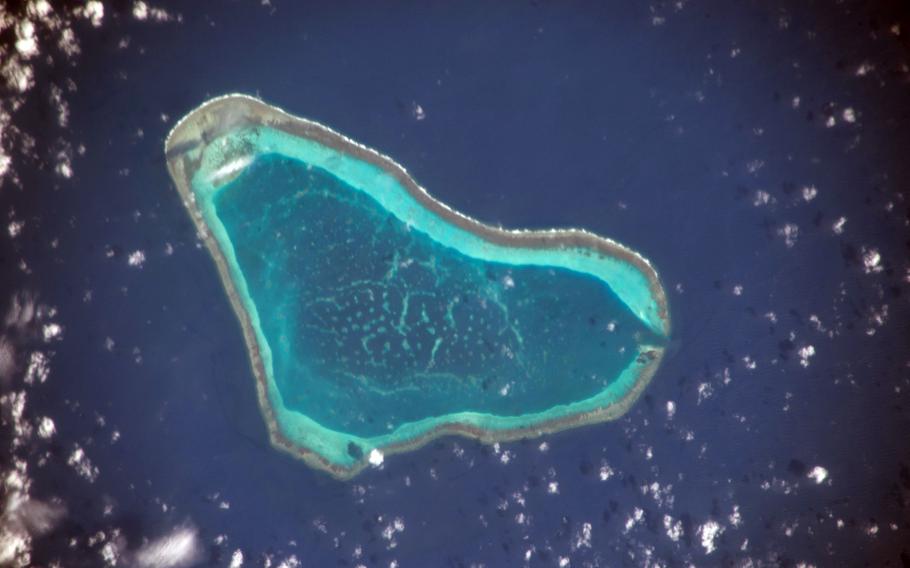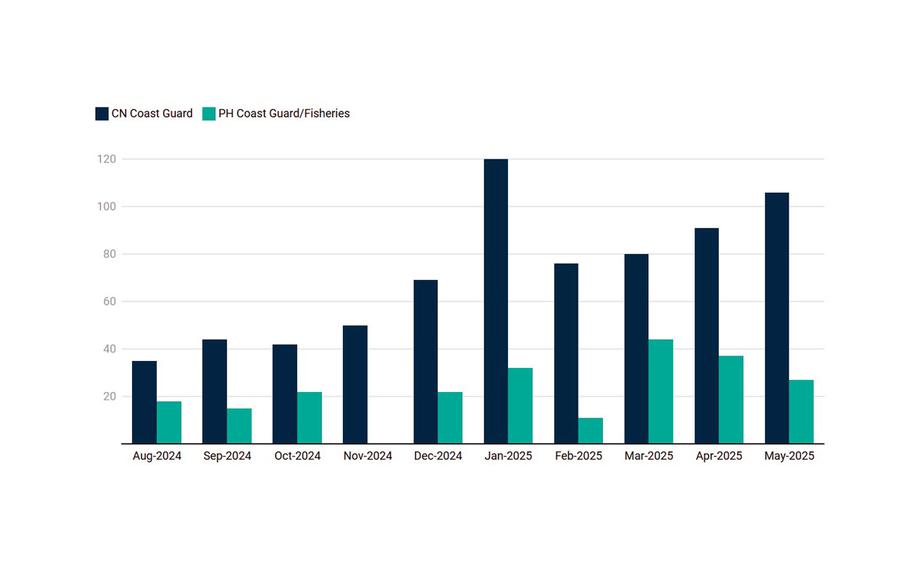
Scarborough Shoal in the South China Sea is seen from the International Space Station in October 2015. (NASA)
Scarborough Shoal has reemerged as the focal point of tensions between Manila and Beijing in the South China Sea, according to a report released Monday by the Asia Maritime Transparency Initiative.
The report found that data from the past 10 months show China has expanded its patrols east of the shoal in an effort “aimed at intercepting Philippine ships, leading to frequent encounters between the two countries’ law enforcement vessels.”
Scarborough Shoal lies about 120 nautical miles west of the Philippines, within its exclusive economic zone, but China has maintained a permanent coast guard presence there since seizing control of the shoal from the Philippines in 2012, said the report by the initiative, a project of the Washington-based Center for Strategic and International Studies.
China claims most of the South China Sea, including various atolls and reefs — many of them uninhabitable — using a “nine-dash line,” a demarcation that encircles much of the sea and skirts the coasts of several Southeast Asian nations.
Vietnam, Taiwan, the Philippines, Malaysia and Brunei also have competing sovereignty claims in the sea.
The United States does not claim territory in the South China Sea but has consistently stated that much of the area is international waters and should remain open to navigation.
The initiative analyzed automatic identification system data from Chinese and Philippine law enforcement vessels between August 2024 and May. The data indicate a roughly threefold increase in Chinese coast guard patrol days during that period.

This bar graph shows the increasing number of monthly patrol days made by Chinese coast guard vessels near Scarborough Shoal from August 2024 to May 2025 as compared to patrol days by Philippine vessels. (Asia Maritime Transparency Initiative)
Increased patrolling east of the shoal coincides with the location of one of the hash marks found on China’s nine-dash map, the report said.
“This suggests that China is using the nine-dash line rather than the territorial sea or another maritime zone from Scarborough as its imagined jurisdictional boundary,” the report said.
• Both countries increased law enforcement activity around the shoal during the 10-month period, but China’s presence was far larger and more consistent. In May, Chinese coast guard ships logged 106 patrol days compared to 27 for Philippine vessels.
• The increased patrols have led to an average of about 12 maritime encounters per month near the shoal.
• Aerial encounters near the shoal also increased. Some have led to “dangerous encounters” between vessels from the two nations.
“In the past ten months, at least four publicly reported air interactions have occurred near Scarborough Shoal,” the report said. “While evocative of the regular unsafe incidents that have occurred between Chinese aircraft and those of the United States and Australia in recent years, this is a new development for the Philippines.”
In August, the Philippines lodged a rare formal protest after a Chinese fighter jet dropped flares in the path of a Philippine air force aircraft, the report said.
“The confluence of increasingly frequent aerial encounters and maritime interactions near Scarborough Shoal inevitably increases the chance of accidental escalation between Chinese and Philippine forces, which could ultimately trigger U.S. treaty obligations and risk spiraling into a wider conflict,” the report concluded.